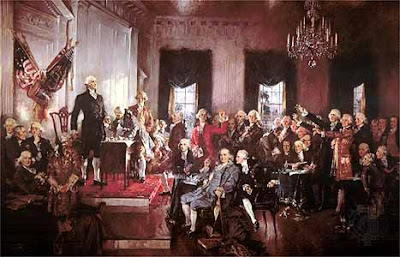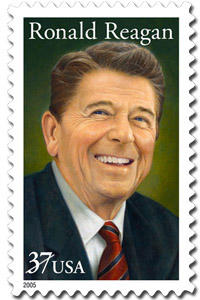
by Marjorie Holsten
In 1787, our young country faced serious problems including bitter division between states, a deeply depressed economy, and high inflation. The Continental Congress operating under the Articles of Confederation called for a convention of delegates (quote) "to devise such further provisions as shall appear to them necessary to render the constitution of the Federal Government adequate to the exigencies of the Union." There were no limits placed on the authority of this convention.
On May 25, 1787 a quorum of delegates met in Independence Hall in Pennsylvania, the same hall where just over a decade earlier 8 of these delegates had signed the Declaration of Independence, birthing our nation.
George Washington was elected president of the convention.
Early on, the men realized that mere revisions to the Articles of Confederation would not be sufficient to solve the nation’s serious problems. America had experienced tyranny under Great Britain with a government that was too powerful. America had also experienced anarchy under the Articles of Confederation with a weak and ineffective government.
To establish a balance between these extremes, these Godly men decided to create a whole new form of government: A Constitutional Republic. They stated their six goals in the Preamble of the Constitution, as follows:
We the People of the United States
1. in Order to form a more perfect Union,
2. establish Justice,
3. insure domestic Tranquility,
4. provide for the common defense,
5. promote the general Welfare, and
6. secure the Blessings of Liberty to ourselves and our Posterity,
do ordain and establish this Constitution for the United States of America.
The founders knew America needed three equal branches of government, with checks and balances so that no one branch became too powerful. For four long, hot months they debated and discussed every detail of the new Constitution, including casting more than 60 ballots solely on the issue of how a president should be elected. They debated the Virginia Plan, the New Jersey Plan, and the Connecticut Compromise.
During one particularly difficult time, Benjamin Franklin, then 81, said "I have lived, sir, a long time, and, the longer I live, the more convincing proofs I see of this truth--that God governs in the affairs of men. And if a sparrow cannot fall to the ground without his notice, is it probable that an empire can rise without his aid? We have been assured, sir, in the sacred writings, that 'Except the Lord build the house, they labor in vain that build it.' I therefore beg leave to move that, henceforth, prayers imploring the assistance of Heaven, and its blessings on our deliberations, be held in this assembly every morning before we proceed to business, and that one or more of the clergy of this city be requested to officiate in that service."
Form that time forward, the Founding Fathers prayed together daily and read the Bible. 34% of all citations during deliberations came from the Bible.
Thomas Jefferson was our Ambassador to France during the Constitutional Convention. He had no part in writing the Constitution. He didn’t write the phrase “Wall of separation between church and state” until 1802 in his letter to the Danbury Baptists. This phrase does NOT exist in our Constitution! The founders who prayed together in the State House clearly did not intend their document to be used to outlaw religion in the public arena.
Finally, on September 17, 1787, 222 years ago today, 39 of the 55 delegates signed the new constitution. Eleven days later, the Continental Congress unanimously approved the new Constitution without any changes and sent it to the states for ratification.
Many states raised objections at their ratifying conventions. Congress encouraged the states to ratify the body of the constitution and attach suggested amendments. The states did just that, attaching 189 Amendments. At the next session of Congress, James Madison distilled these down to 12 amendments, of which ten were finally approved and ratified by the states. These are known collectively as the Bill of Rights and use language such as “Congress shall make NO LAW respecting an establishment of religion…” “The right of the people to keep and bear arms SHALL NOT be infringed, and” the right of the people to be secure in their houses SHALL NOT be violated.”
Patrick Henry said, “The Constitution is not an instrument for the government to restrain the people, it is an instrument for the people to restrain the government."
The Constitution went into effect March 4, 1789. The first national "Thanksgiving Day" was originally created by George Washington in November of 1789 as a way of "giving thanks" for our Constitution.
Our constitution, article by article
This brilliant document, bathed in prayer, consists of a Preamble, 7 Articles, and 27 Amendments.
Article 1 governs the organization and powers of Congress. Section eight contains a list of 18 clauses, each with a specific duty of Congress. The first Clause is the “General Welfare Clause,” which states “Congress shall have the power to lay and collect taxes… for the general welfare of the United States….
There are 17 more clauses in Section 8 enumerating specific duties of congress – we call these the enumerated powers. If the Founding Fathers had intended Congress to have unlimited authority, they would not have written specified additional duties after creating a “general welfare” clause. Clearly the founders intended to have limits on Congressional authority.
When you read the list, you will see that the enumerated powers do NOT include
- the power to take over private companies
- the power to bail out failing companies
- the power to take over health care
- the power to regulate what is taught in classrooms.
There is a name for actions taken without Constitutional authority: UNCONSTITUTIONAL.
Article 2 deals with the Executive Branch of government and provides that “No person except a natural born Citizen shall be eligible to the Office of the President.” The current President has not produced a valid birth certificate proving his eligibility. He has spent significantly more than a million dollars fighting attempts to require that he produce one. On January 21st, 2009, his very first day in office, Obama signed Executive Order 13489 sealing his records.
Article 3 deals with the Judicial Branch and establishes the Supreme Court of the United States. The judicial branch does NOT have legislative or policy-making authority – only congress composed of elected officials can make laws. When the court oversteps its bounds, we have Judicial Tyranny.
Article 4 contains provisions relating to the states, including the Full Faith and Credit Clause. Under this clause, the marriage I entered into with my husband in Minnesota many years ago is to be honored in all 50 states. The founding fathers never intended this clause to be a foundation for gay marriage across America.
Article 5 provides the rules for amending the Constitution. If our founding fathers had intended the Constitution to be a “living, breathing document, there would be no need to amend it. We do NOT have a living Constitution. If a provision of the Constitution is unclear, one is discern the original intent of the founding fathers. More than 15,000 records from the convention exist today. It is not hard to discern the intent of these God-fearing men. One thing is clear: Our founders NEVER intended the Constitution to allow the murder of 50 million babies.
Article 6 provides that the Constitution is the Supreme Law of the Land. This means that Supreme Court justices are NOT to look at international law when they interpret OUR Constitution.
Lastly, Article 7 provides the rules for the original ratification of the Constitution.
I challenge every one of you to read the Constitution.
To conclude, I would like to quote the 30th president of the United States, Calvin Coolidge, who said “To live under the American Constitution is the greatest political privilege that was ever accorded to the human race.”
We the People, may God Bless you!
Attorney Marjorie Holsten delivered this speech at the Constitution Day Tea Party, September 17, 2009, at the Minnesota State Capitol. Holsten is a wife, mother, and attorney. She homeschools her children and teaches Constitutional Law to many homeschoolers. Ms. Holsten is president of 10-PACK: Politically Active Conservative Kids campaigning in 2010. She can be reached at marjholsten@yahoo.com.
See the National Constitution Day web site, sponsored by the National Constitution Center, for much more information, and learning resources for K-12 students, about the Constitution.




No comments:
Post a Comment